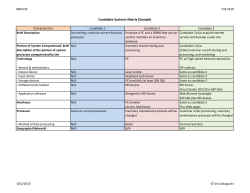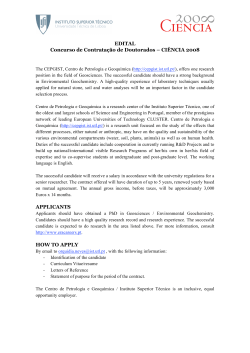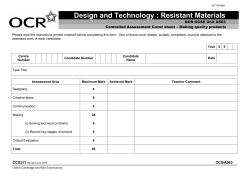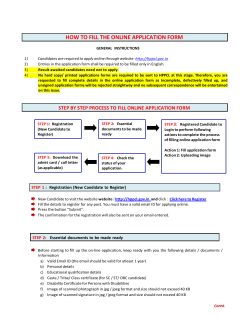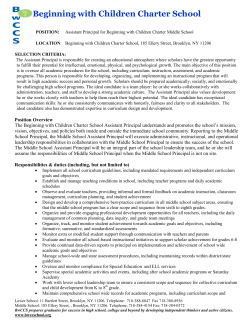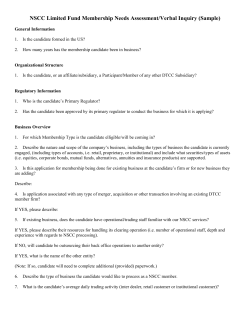
MARSHALL UNIVERSITY COLLEGE OF EDUCATION TEACHER EDUCATION PROGRAM
MARSHALL UNIVERSITY COLLEGE OF EDUCATION TEACHER EDUCATION PROGRAM Revised: August, 2011 All teacher candidates will create a Teacher Candidate Work Sample (TCWS) analyzing a sample of their work and the degree to which their students have learned. They will also make an oral presentation to demonstrate communication skills as they explain the contents of the TCWS. The purpose of the TCWS is to facilitate critical and reflective thinking about the teaching and the degree to which students have learned. The TCWS will also be a part of the assessment of knowledge and performance in relation to the West Virginia Professional Teaching Standards (WVPTS). The oral presentation is an assessment of the presentation skills and the ability to articulate thoughts about the semester. West Virginia Professional Teaching Standards: Standard 1 – Curriculum and Planning Function 1A – Core Content Function 1B – Pedagogy Function 1C – Setting Goals and Objectives for Learning Function 1D – Designing Instruction Function 1E – Student Assessments Standard 2 – The Learner and the Learning Environment Function 2A – Understanding Intellectual/Cognitive, Social, and Emotional Development Function 2B – Creating an Environment of Respect and Rapport Function 2C – Establishing a Culture for Learning Function 2D – Implementing Classroom Procedures Function 2E – Managing Student Behaviors Function 2F – Organizing the Learning Environment Standard 3 – Teaching Function 3A – Importance of Content Function 3B – Communicating with Students Function 3C – Questioning and Discussion Techniques Function 3D – Student Engagement Function 3E – Use of Assessments in Instruction Function 3F – Flexibility and Responsiveness Standard 4 – Professional Responsibilities for Self-Renewal Function 4A – Professional Learning Function 4B – Professional Collaborative Practice Function 4C – Reflection on Practice Function 4D – Professional Contribution Standard 5 – Professional Responsibilities for School and Community Function 5A – School Mission Function 5B – School-wide Activities Function 5C – Learner-Centered Culture Function 5D – Student Support Systems Function 5E – Student Management Systems Function 5F – School, Family and Community Connections Function 5G – Strategic Planning/Continuous Improvement Function 5H – Teacher Leadership Function 5I – Ethical Standards GOALS TCWS Standard: The teacher candidate sets realistic goals that he/she would like to accomplish during the student teaching placement. WV Professional Teaching Standards: 1, 4 Task: List 3-5 goals that will enhance your professional growth and teaching performance. Some examples of goals might be: To create a positive learning environment To find ways to integrate technology into my unit and lessons To improve communication skills To address educational needs of diverse learners At least one goal should be directed toward your specific content area. Suggested page length: ½ of a page DISTINGUISHED PROFICIENT BASIC UNSATISFACTORY (4 points) (3 points) (2 points) (1 point) GOALS OF TEACHING GOALS Candidate goals are insightful, reasonable and attainable. Candidate goals are reasonable and attainable. Candidate goals are reasonable but not attainable. Candidate goals are neither reasonable nor attainable. SCORE CONTEXTUAL FACTORS TCWS Standard: The teacher candidate uses information about the learning-teaching context and student individual differences to set the learning goal and objectives and plan instruction and assessment. WV Professional Teaching Standards: 2, 5 Task: Identify relevant factors and how they may affect the learning-teaching process. Include any supports and challenges that affect instruction and student learning. (Caution: Comments on the community or students that are negative, prejudicial, or stereotypical are not helpful in completing this assignment. Use good judgment in selecting and describing your contextual factors as this document may be reviewed in the licensure process.) Prompt: Read the scoring rubric in advance and organize your Contextual Factors using the following subheadings: A. B. C. D. E. Community, District, and School Factors Address topics that could affect teaching and learning, such as geographic location, community and school population, socio-economic profile, race/ethnicity, political climate, community support for education. Classroom Factors Address classroom factors that affect teaching and learning such as physical features, availability of technology equipment, the extent of parental involvement, classroom rules and routines, grouping patterns, scheduling, classroom arrangement. Student Characteristics Identify student characteristics you must consider as you design instruction and assess learning. Include factors such as age, gender, race/ethnicity, special needs, achievement/developmental levels, culture, language, interests, students’ skill levels. Instructional Implications Using the contextual factors you have recorded in A, B, and C above, identify and prioritize at least 4 implications for your teaching and assessment. In your written description, you may want to number the most important contextual factors and their matching implications to ensure community, district, school, classroom, and student characteristics have been carefully considered in identifying implications. Content Specific Factors Identify content specific factors that must be considered as you plan your unit, such as content series, lab instruction, writing across the curriculum. ***For each factor you describe, you must analyze how that factor impacts teaching and learning. Suggested Page Length: 3-4 pages DISTINGUISHED PROFICIENT BASIC UNSATISFACTORY (4 points) (3 points) (2 points) (1 point) Candidate displays complex knowledge of the characteristics of the community and school that may affect learning. Candidate displays complex knowledge of the characteristics of the classroom that may affect learning. Candidate displays complex knowledge of the characteristics of the students that may affect learning. Candidate displays specific knowledge of the characteristics of the community and school that may affect learning. Candidate displays specific knowledge of the characteristics of the classroom that may affect learning. Candidate displays specific knowledge of the characteristics of the students that may affect learning. Candidate provides complex implications for instruction and assessment based on student individual differences and community, school, and classroom characteristics. Candidate displays complex knowledge of the subject matter and how it will affect student learning. Candidate provides specific implications for instruction and assessment based on student individual differences and community, school, and classroom characteristics. Candidate displays specific knowledge of the subject matter and how it will affect student learning. CONTEXTUAL FACTORS COMMUNITY, DISTRICT & SCHOOL FACTORS CLASSROOM FACTORS STUDENT CHARACTERISTICS INSTRUCTIONAL IMPLICATIONS CONTENT SPECIFIC FACTORS Candidate displays some knowledge or biased knowledge of the characteristics of the community and school. Candidate displays some knowledge or biased knowledge of the characteristics of the classroom. Candidate displays general or minimal understanding of student differences (e.g., culture, development, interests, abilities) that may affect learning. Candidate provides general implications for instruction and assessment based on student individual differences and community, school, and classroom characteristics. Candidate displays minimal or general knowledge of the subject matter and how it will affect student learning. Candidate displays minimal, irrelevant or no knowledge of the community and school. Candidate displays minimal, irrelevant or no knowledge of the classroom. Candidate displays stereotypical, irrelevant or no knowledge of student differences. Candidate provides inappropriate or no implications based on contextual factors. Candidate displays inappropriate or no knowledge of the subject matter and how it will affect student learning. SCORE LEARNING GOALS AND OBJECTIVES TCWS Standard: The teacher candidate sets significant, challenging, varied and appropriate the learning goal and objectives based on state/district content standards. WV Professional Teaching Standards: 1, 2, 3 Task: You will create a framework for your unit to provide and justify objectives that are logically organized and move students toward achieving the learning goal. Prompt: Read the scoring rubric in advance and use the chart below to provide the following information: A. BIG IDEA Identify a clear unit outcome or learning goal based on the State Core Curriculum (not the activities) that will guide the planning, delivery and assessment of your unit. This goal should define what you expect students to know and be able to do at the end of the unit. STANDARDS Cite the state or district standard(s)/objective(s) used as a basis for the unit outcome with all reference numbers. STUDENT OBJECTIVES (Measurable skills from the unit KUDs that move the student toward achieving the big idea.) Identify at least three objectives that move students toward achieving the big idea. The objectives should be varied and challenging and reflect levels of Depth of Knowledge. Number each objective so you can reference them later in your Assessment Plan and unit Outline. TYPE/LEVEL OF OBJECTIVES Using a relevant critical thinking hierarchy, such as: Depth of Knowledge (recall, skills/concepts, strategic thinking, extended thinking) Bloom’s Taxonomy (knowledge, comprehension, application, analysis, synthesis, evaluation) Label and describe the levels of learning represented in each objective. APPROPRIATENESS FOR STUDENTS’ DEVELOPMENT Explain why each objective is appropriate for students’ development, pre-requisite knowledge, etc. B. C. D. E. BIG IDEA: STANDARDS STUDENT OBJECTIVES TYPE/LEVELS OF OBJECTIVES APPROPRIATENESS FOR STUDENTS’ DEVELOPMENT 1. Expand table as needed. Suggested page Length: 1-2 page DISTINGUISHED PROFICIENT BASIC UNSATISFACTORY (4 points) (3 points) (2 points) (1 point) LEARNING GOALS AND OBJECTIVES OF UNIT BIG IDEA STANDARDS STUDENT OBJECTIVES TYPE/LEVEL OF OBJECTIVES APPROPRIATENESS FOR STUDENTS The big idea is insightful and sets high expectations for what students will know at the end of the unit; aligns with local, state, or national standards. State and national standards are clearly stated with reference numbers. The big idea is clearly stated that defines what you expect students to know at the end of the unit; aligns with local, state, or national standards. Some state and national standards are clearly stated with some reference numbers. The big idea is stated, but alignment to local, state, or national standards is not clear. Big idea is not stated clearly and/or is not stated; there is no alignment with local, state, or national standards. State and national standards are stated but not with reference numbers. Objectives reinforce learning outcomes (what the students will be able to know, understand, and do) and align with national, state, or local standards. Objectives support the learning outcomes (what the students will be able to know, understand, and do) and align with national, state or local standards. Objectives reflect multiple levels of learning and are significant/challenging. Objectives are consistently appropriate for the development, pre-requisite knowledge, skills, experiences, and other student needs. Objectives reflect several levels of learning and are significant/challenging. Objectives are adequately appropriate for the development, pre-requisite knowledge, skills, experiences, and other student needs. Some objectives support the learning outcomes (what the students will be able to know, understand, and do) and align with national, state or local standards. Objectives reflect few levels of learning and lack significance/challenge. Some objectives are appropriate for the development, prerequisite knowledge, skills, experiences, and other student needs. State and national standards are not clearly stated or not stated at all; reference numbers are not used. Objectives do not support the learning outcomes and do not align with national, state or local standards. Objectives reflect only one level of learning. Objectives are not appropriate for the development, prerequisite knowledge, skills, experiences, or other student needs. SCORE ASSESSMENT PLAN TCWS Standard: The teacher candidate uses multiple assessment methods aligned with the learning goal and objectives to assess student learning before, during and after instruction. WV Professional Teaching Standards: 1, 2, 3 Task: Using the Assessment Plan Chart (below), you must design an assessment plan used to monitor student progress toward the learning objectives. Plan appropriate assessment measures for assessing student learning before instruction (pre-assessments), during instruction (interim or formative assessment), and after instruction (post or summative assessments). Assessment methods may include constructed response, selected response (i.e., multiple-choice tests, true or false), essay (essay examinations, take-home essays, etc.), performance assessment (i.e., reading aloud, performance event, performance task, communicating conversationally in a second language, carrying out a specific motor activity in physical education, delivering a speech, etc.), and personal communications (i.e., questions posed and answered during instruction, interviews, conferences, etc.). Your instructional sequence should include a variety of assessment methods and strategies suited for the developmental level of the students and your learning objectives. You must also state and defend the criteria you will use for determining the accomplishment of each learning objective. The key to writing this section of your Teacher Candidate Work Sample is the alignment between your learning objectives and assessment methods and strategies. You must construct a table that lists 3-5 learning objective (see Learning Goals and Objectives section), the assessments used to assess student performance relative to each learning objective, and a rationale for each assessment that explains why you chose or developed the assessment. Prompt: Read the scoring rubric in advance and use the chart below to provide the following information: STUDENT OBJECTIVE (DO) 1. CONTENT SPECIFIC ASSESSMENTS (Methods matched to outcome types and content area) RATIONALE OF ASSESSMENTS PreAssessment Formative PostAssessment Expand table as needed. Include copies of assessments, the student directions for the assessments, and criteria for scoring student performance (e.g., scoring rubrics, observation checklists, rating scales, answer keys) in Appendix A: Assessments. Suggested Page Length: 2-3 pages (Assessment Plan) + assessment instruments __________________________________________________________________________________________ DISTINGUISHED PROFICIENT BASIC UNSATISFACTORY (4 points) (3 points) (2 points) (1 point) LEARNING GOALS AND OBJECTIVES OF UNIT CONTENT SPECIFIC ASSESSMENTS RATIONALE OF ASSESSMENTS The plan is designed with multiple assessments carefully chosen to fit the content and the student skill level in their complexity (e.g., Bloom). Rationale for assessments is clearly thought out to reflect mastery of the content students will learn. The plan includes multiple assessments with a variety of modes that fit the content and the student skill level in their complexity (e.g., Bloom). Rationale for assessments is somewhat thought out to reflect the content students will learn. The plan includes some assessments with a variety of modes that fit the content and the student skill level in their complexity (e.g., Bloom). Rationale for assessments doesn’t align with the content that students will learn. Few to no assessments represent a variety of modes that fit the content and the student skill level in their complexity (e.g., Bloom). Rationale for assessments chosen is not included. SCORE DESIGN FOR INSTRUCTION/TEACHING UNIT INSTRUCTIONAL PLANS TCWS Standard: The teacher candidate designs instruction for the specific learning goal and objectives that address characteristics and needs of students, and the learning context. WV Professional Teaching Standards: 1, 2, 3 Task: Design the lessons for your unit based on the learning goal and objectives, students’ characteristics and learning context. Pre-assessment data must be used to guide development or modification of your unit. Include all lessons in unit plan. After administering the pre-assessment, analyze student performance relative to the objectives. Provide a narrative description of the results and how the results shaped your instruction. Include unit plan with daily lesson plans – make sure to include all examples of resources used in this unit. Prompt: Read the scoring rubric in advance. Suggested Page Length: 2 pages (Pre-Assessment graph with narrative) + unit DISTINGUISHED PROFICIENT BASIC UNSATISFACTORY (4 points) (3 points) (2 points) (1 point) DESIGN FOR INSTRUCTION/TEACHING UNIT INSTRUCTIONAL PLANS PRE-ASSESSMENT AND CONTEXTUAL INFORMATION INSTRUCTIONAL STRATEGIES OVERALL UNIT PLAN Pre-assessment data are charted, analyzed, and consistently used to design and delivery instruction. Pre-assessment data are charted, analyzed, and used to fine tune instructional design and delivery. Pre-assessment data are charted, analyzed and some evidence is provided that the data influenced instructional design. Learning activities are chosen to consistently reflect best practices in the teaching major and are suited to the instructional setting. Lessons are specific and relevant; student interest/engagement is above expectations. Unit/lesson plans and all other resources are included. Learning activities reflect best practices in the teaching major and are suited to the instructional setting. Some learning activities reflect best practices in the teaching major. Lessons are logically sequenced; student interest/engagement is high. Unit/lesson plans and all other resources are included. Lessons are somewhat logically sequenced; student interest/engagement would be good. Unit/lesson plans are included, but other resources are not included. Pre-assessment data have not been charted and analyzed or there is no evidence that the information has been used in instructional design. Few learning activities reflect best practices in the teaching major. Lessons are disorganized. Student interest/engagement would be low. Lessons plans and other resources are not included. SCORE INSTRUCTIONAL DECISION-MAKING TCWS Standard: The teacher candidate uses on-going analysis of student learning to make instructional decisions. WV Professional Teaching Standards: 1, 2, 3, 4 Task: Based upon the experiences you gained from teaching your unit, describe a daily instructional strategy/activity and its assessment. Explain how the assessment caused you to modify the next day’s plan. Include an example for each day of the unit. Prompt: Read the scoring rubric in advance and use the chart below to organize your Instructional Decision-Making using the following information: A. B. C. INSTRUCTIONAL STRATEGY/ACTIVITY Identify one instructional strategy/activity for each day of the unit that was used (select a variety of instructional strategies/activities). ASSESSMENT Identify the assessment (i.e., written test, observation checklist, interview, lab exercise) that was used to evaluate the students’ understanding. REFLECTIVE ACTION PLAN Based on the analysis of the assessment and content standards, where will you go from this point? What will you do in the next lesson? DAYS TEACHING UNIT Day 1 REFLECTIVE ACTION PLAN (Where do I go from here?) ASSESSMENT INSTRUCTIONAL STRATEGY/ACTIVITY Expand table as needed. Suggested Page Length: 3-5 pages DISTINGUISHED PROFICIENT BASIC UNSATISFACTORY (4 points) (3 points) (2 points) (1 point) INSTRUCTIONAL DECISION-MAKING INSTRUCTIONAL STRATEGY/ ACTIVITY ASSESSMENT REFLECTIVE ACTION PLAN Instructional strategies/activities were chosen for every day of the unit. Instructional strategies/activities were chosen for most days of the unit. Instructional strategies/activities were chosen for about half of the days of the unit. Instructional strategies/activities were chosen for less than half of the days of the unit. Assessments were included for all instructional strategies/activities listed. Candidate provides thoughtful insights for the next action based on the assessment data. Assessments were included for most of the instructional strategies/activities listed. Candidate provides a complete plan for the next action based on the assessment plan. Assessments were included for about half of the instructional strategies/activities listed. Candidate some insights for the next action based on the assessment data. Assessments were included for less than half of the instructional strategies/activities listed. Candidate does not provide a plan based on the assessment data. IMPACT ON STUDENT LEARNING TCWS Standard: The teacher candidate uses assessment data to profile student learning and communicate information about student progress and achievement. WV Professional Teaching Standards: 1, 2, 3 Task Report the results of your assessments, including pre/post assessments and formative assessments to determine students’ progress related to the learning goal and objectives. Use charts, graphs and narrative to identify the performance of the whole class and two individual students. Prompt: Read the scoring rubric in advance and organize your Analysis of Student Learning using the following subheadings: A. B. WHOLE CLASS – Create a graph or table that shows every student and his/her performance on pre- and post-assessments on the learning goal and each objective. Summarize what the data show about student learning in the whole class. How many students met the objectives? How many did not? TWO INDIVIDUALS – Select two students who exhibit divergent performance levels on one learning objective in the unit. Provide a rationale for your selection of these two students. Create a graph or table that shows the performance of the two individuals on pre- and postassessments on one objective. Summarize what these data show about student learning for these individuals. NOTE: You will provide possible reasons for why your students learned (or did not learn) in the next section, “Reflection and Self-Evaluation.” Suggested Page Length: 2 pages (1 per chart with summary) DISTINGUISHED PROFICIENT BASIC UNSATISFACTORY (4 points) (3 points) (2 points) (1 point) IMPACT ON STUDENT LEARNING Provides an in-depth profile of student learning supported by data. Summary is meaningful and high-level conclusions are drawn from the data. Provides a clear profile of student learning supported by data. Summary is meaningful and appropriate conclusions are drawn from the data. Data Summary Extensive evidence is provided on learner achievement and progress toward the learning goal and/or each objective. Provides an in-depth profile of student learning supported by data. Summary is meaningful and high-level conclusions are drawn from the data. Adequate evidence is provided on learner achievement and progress toward the learning goal and/or each objective. Provides a clear profile of student learning supported by data. Summary is meaningful and appropriate conclusions are drawn from the data. Impact On Student Learning Extensive evidence is provided on who achieved and made progress toward the learning goal and/or each objective. Adequate evidence is provided on who achieved and made progress toward the learning goal and/or each objective. WHOLE CLASS Profile Clarity Data Summary Impact On Student Learning INDIVIDUAL STUDENTS Profile Clarity Some parts of the profiles are unclear. Profile is unclear. Summary includes some meaningful and appropriate conclusions drawn from the data. Little evidence is provided on learner achievement and progress toward the learning goal/objectives. Some parts of the profiles are unclear. Summary is inaccurate or conclusions are missing or not supported by data. Summary includes some meaningful and appropriate conclusions drawn from the data. Little evidence is provided on who achieved and made progress toward the learning goal/objectives. Summary is inaccurate or conclusions are missing or not supported by data. No evidence is provided on learner achievement. Profile is unclear. No evidence is provided on who achieved and made progress toward the objective. REFLECTION AND SELF-EVALUATION TCWS Standard: The teacher candidate analyzes the relationship between his or her instruction and student learning in order to improve teaching practice. WV Professional Teaching Standards: 1, 2, 3, 4, 5 Task: Evaluate your performance as a teacher and link your performance to student learning results. Reflect on your performance and identify future action that could improve your teaching and professional growth. Identify the learning activity where your students were most successful and the learning activity where your students were least successful. Prompt: Read the scoring rubric in advance and organize your Reflection and Self-Evaluation using the following subheadings: A. B. C. D. E. F. ANALYSIS OF STUDENT TEACHING GOALS – Reflect on the progress you’ve made toward each of your student teaching goals. INTERPRETATION OF STUDENT LEARNING – Identify possible reasons for students’ success and lack of success based on your assessment results. Consider student characteristics, objectives, instruction, materials and assessment as well as other contextual factors. INSIGHTS ON EFFECTIVE INSTRUCTION AND ASSESSMENT – Identify the most successful and least successful learning activities based on student performance. Provide a rational for your selections. CONSIDERATION OF CONTENT INSTRUCTION – Describe your strengths and challenges in delivering content-specific instruction. IMPLICATIONS FOR FUTURE TEACHING – Describe what you did well and what you could differently or better in the future to improve your students’ performance. IMPLICATIONS FOR PERSONAL PROFESSIONAL IMPROVEMENT – Identify at least two areas for improvement that emerged during this unit. List and describe specific professional activities you will engage in to improve your performance as a teacher in these areas. Suggested Page Length: 3-5 pages DISTINGUISHED PROFICIENT BASIC UNSATISFACTORY (4 points) (3 points) (2 points) (1 point) Provides thorough reasons for why students met or did not meet the learning goals and objectives. Identifies the most and the least successful activities and assessments and explores plausible, and in-depth reasons for their success or failure. Provides specific and relevant ideas for redesigning instruction and assessment and explains in detail why these changes would improve student learning. Provides adequate reasons for why students met or did not meet the learning goals and objectives. Identifies the most and the least successful activities and assessments and explores plausible reasons for their success or failure. Provides ideas for redesigning instruction and assessment and explains why these changes would improve student learning. Identifies more than two areas for improvement and lists and describes a comprehensive plan to improve these areas. Identifies two areas for improvement and lists and describes specific professional activities to improve in these areas. REFLECTION AND SELF-EVALUATION INTERPRETATION OF STUDENT LEARNING INSIGHTS ON EFFECTIVE INSTRUCTION AND ASSESSMENT IMPLICATIONS FOR FUTURE TEACHING IMPLICATIONS FOR PERSONAL PROFESSIONAL IMPROVEMENT Provides few reasons for why students met or did not meet the learning goals and objectives. No evidence or reasons provided to explain students performance. Identifies few activities and provides little rationale for why some activities or assessments were more successful than others. Provides few ideas for redesigning instruction, and assessment or offers an inadequate explanation of why these changes would improve student learning. Identifies areas for improvement and describes general activities to improve in these areas. Provides no rationale for why some activities or assessments were more successful than others. Provides inappropriate or no ideas for redesigning instruction, and assessment. Does not clearly identify areas for improvement or provides a poor plan or no plan to improve in these areas. DISPOSITIONS AND QUALITY OF WORK SAMPLE DISTINGUISHED PROFICIENT BASIC UNSATISFACTORY (4 points) (3 points) (2 points) (1 point) Candidate occasionally demonstrates the ability to evaluate, critically analyze, reflect, and problem solve at a higher level of thinking. Candidate occasionally demonstrates instructional design that meets the needs, interests and abilities of some students. Some descriptions related to diversity show respect and understanding issues of diversity. Some expectations are low. Candidate occasionally integrates available technology meaningfully into professional and instructional practices. Candidate inconsistently examines his/her practice through a continuous cycle of on-going professional improvement. Candidate rarely demonstrates the ability to evaluate, critically analyze, reflect, and problem solve at a higher level of thinking. Candidate rarely demonstrates instructional design that meets the needs, interests and abilities of some students. DISPOSITIONS CRITICAL THINKING COMMITMENT TO STUDENTS COMMITMENT TO DIVERSITY COMMITMENT TO TECHNOLOGY COMMITMENT TO PROFESSION Candidate consistently demonstrates the ability to evaluate, critically analyze, reflect, and problem solve at a higher level of thinking. Candidate consistently demonstrates instructional design that meets the needs, interests and abilities of all students. Descriptions related to diversity exceed expectations for respect, understanding issues of diversity and high expectations. Candidate consistently integrates available technology meaningfully into professional and instructional practices. Candidate critically examines his/her practice through a continuous cycle of on-going professional improvement. Candidate frequently demonstrates the ability to evaluate, critically analyze, reflect, and problem solve at a higher level of thinking. Candidate frequently demonstrates instructional design that meets the needs, interests and abilities of all students. Descriptions related to diversity show respect, understanding issues of diversity and high expectations. Candidate frequently integrates available technology meaningfully into professional and instructional practices. Candidate examines his/her practice through a continuous cycle of on-going professional improvement. There are no spelling, grammar, capitalization, punctuation, sentence structure, and all other mechanics of writing errors. There are very few spelling, grammar capitalization, punctuation, sentence structure, and all other mechanics of writing errors. Sections are well organized. Required information is clearly presented and easy to find. There are some spelling, grammar, capitalization, punctuation, sentence structure, and all other mechanics of writing errors. Some sections are well organized. Some information presented is easy to find. There are many spelling, grammar, capitalization, punctuation, sentence structure, and all other mechanics of writing errors. Few sections are well organized. Some information presented was difficult to find. TCWS reflects the typical professional thought and effort expected in a culminating teaching assignment. TCWS has sections that should be revised and improved before serving s a culminating assignment. TCWS does not reflect the typical professional thought and effort expected in a culminating teacher education assignment. Descriptions related to diversity do not show respect and in understanding issues of diversity. Expectations are low. Candidate rarely integrates available technology meaningfully into professional and instructional practices. Candidate fails to examine his/her practice through a continuous cycle of on-going professional improvement. QUALITY OF WORK SAMPLE MECHANICS OF WRITING ORGANIZATION OVERALL TCWS QUALITY TCWS is creative and neatly organized according to the table of contents. Required information is clearly presented and easy to find. TCWS reflects mastery in professional thought and effort expected in a culminating teaching assignment.
© Copyright 2025

